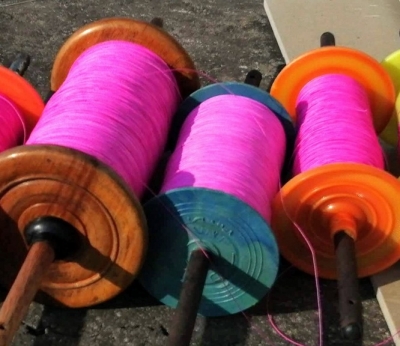Banned in 2017, Chinese manjha still claims lives; cops tighten noose around sellers

New Delhi, July 31 : The country will be celebrating its 75th Independence Day in just a fortnight and the skies will be filled with colourful kites, adding a special flavour to the pan-India celebrations.
Kite flying has been an integral part of Indian culture for several decades, especially during the time of Independence Day.
Turning over the pages of history, the tradition of kite flying around August 15 began during India’s freedom movement to counter British rule. British politician, John Simon, was supposed to arrive in India in 1928 to study constitutional reforms in Britain’s largest and most important possession.
However, the Simon Commission was opposed ‘tooth and nail’ by the Indians and the slogans of ‘Simon Commission Go Back’ rented the air of the Indian subcontinent. It was at that time, some people chose to fly kites with ‘Simon Commission Go Back’ written on it and years later after India gained Independence, it became a tradition.
But who would have thought that such a delightful sport would one day become a serious cause of concern!
The problem is not with the tradition of kite flying but the thread, popularly known as Chinese Manjha, used to fly it. The manufacturers of Chinese Manjha use glass and metal powder coating over it which at times causes grievous and fatal injuries to humans and birds.
After much deliberations, Delhi government had banned the sale, production, storage, supply, import, and use of kite flying thread made out of nylon, plastic or any other synthetic material, including popularly known as “Chinese manjha” and any other kite-flying thread that is sharp or made sharp such as by being laced with glass, metal or any other sharp materials in the National Capital Territory of Delhi in 2017, however, even after five years of prohibition, the dangerous thread is still claiming lives of humans, birds and even animals.
But how is this thing killing people?
Kite flying is a popular sport in Delhi and it catches pace weeks before, during and after the Independence Day celebrations in the month of August every year. The sport of kite flying is played between two people. The way to win the battle is by severing the kite thread of the rival. However, the severed thread plummets downwards often entangling between streets and roads causing injuries to an unsuspecting pedestrian or even death to a two-wheeler-borne person.
Just a few days back on July 26, a father lost his 30-year-old son, identified as Sumit Ranga, when the latter, riding on his motorcycle, got his throat slit with a Chinese Manjha on the Haiderpur Flyover in northwest Delhi. Sumit was rushed to the hospital, but it was too late for him.
This was not an isolated case but every year, deaths due to the kite strings are reported from several parts of the country. The number of incidents involving Chinese manjha is the highest in the last week of July and first half of August when kite flying happens the most.
The police in the national capital are presently on toes to avert such tragedies and are vigorously conducting raids to nab the suppliers of such kinds of strings.
“These banned kite flying threads are stronger due to coating of metallic powder but are very dangerous due to its innocuous nature which makes it easy for birds to get tangled in the string while flying or even sitting on trees,” a senior Delhi Police official told IANS.
It is due to this sharp powdered metal coating, the Chinese Manjha easily slices through flesh, leaving the humans, animals and birds gravely injured. “While there is a ban on all types of such manjha, many vendors still sell it. Most offenders get away as it is difficult to trace them,” the senior official said.
In this regard, Assistant Commissioners of Police in several districts of Delhi have issued notifications with order that no person shall store, sell and use the special manjha with metallic powder or glass coating.
“It has become very difficult to find clues regarding culprits involved in selling ‘Chinese Manjha’ because they take utmost care in this activity. It was found that they have adopted tactics to not sell it directly in the market to every customer but selling the same in discreet manner on demand by using codewords etc,” the official said.
During continuous raids, the police found that wholesalers of Chinese Manjha were receiving demands on telephone only from their identified retailers through codewords and were delivering the same by opening their locked godowns for a very short time preferably during the night hours.
Recently, a storage house full of Chinese Manjha, having 205 cartons containing 11,760 rolls, was busted in northwest Delhi. Apart from the northwest district, several people have been booked in other districts of the national capital along with recovery of large quantities of illegal strings.






